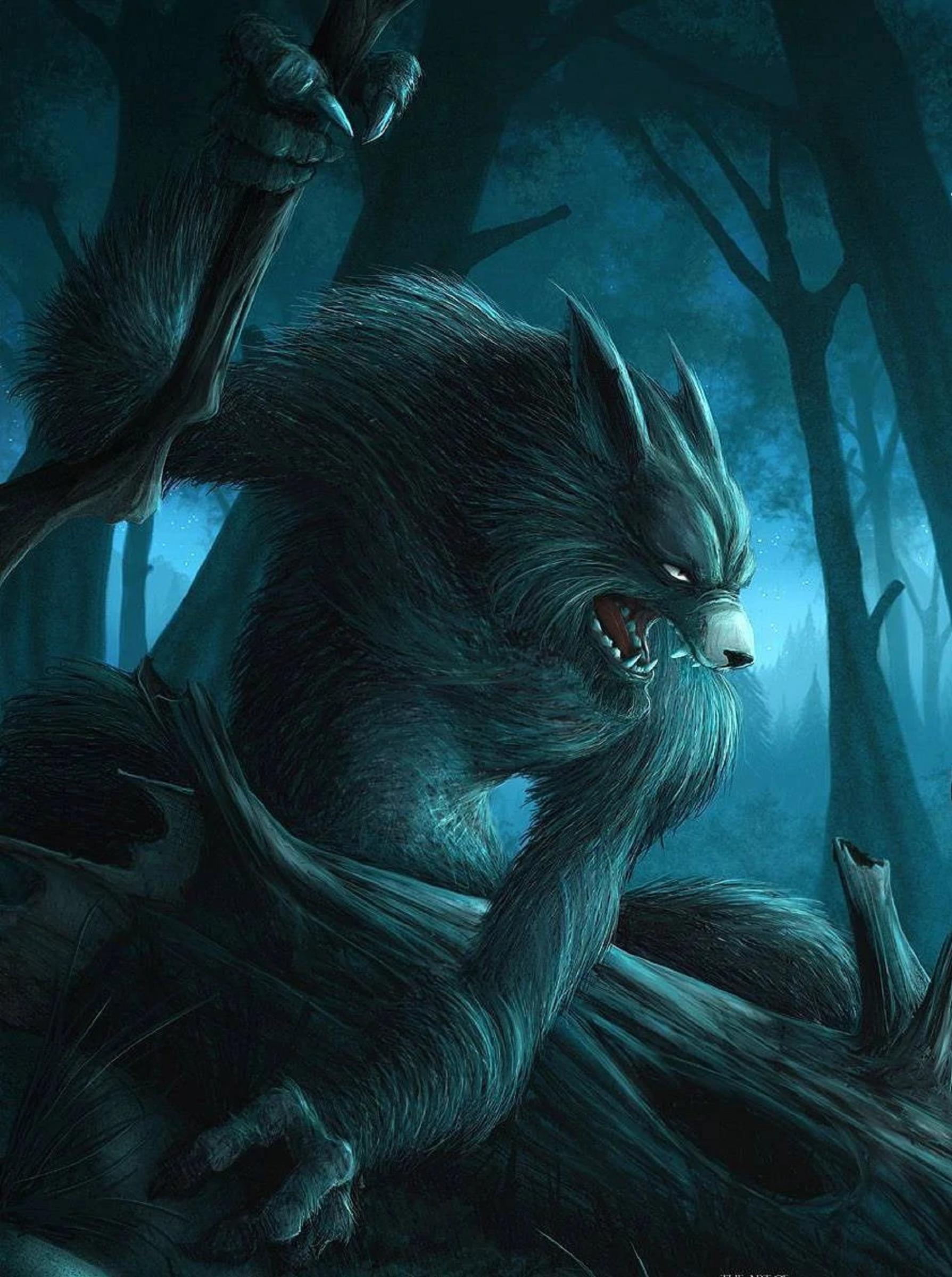
The tales and history of Werewolves have always been a fascination of mine and I will be posting more about the folklore regarding these creatures in cultures throughout the world. Today however I want to share with you all about the folklore of the Vilkacis (Vilkatis) which are the Werewolves of Latvia.
In some countries there are legends of humans that are actually able to send their soul into another creature. The vilkacis – which are what the werewolves of Latvia are known as (Latvia is a country in Northern Europe) are rumored to be able to do this. Some stories of the Latvian werewolves (vilkacis) say that the werewolves aren’t actually humans that transform into wolves, but rather humans that send their souls into wolves! The process is a dangerous – and sometimes deadly one – as sometimes once the soul has left the human body it can be hard for the soul to return back into it’s own body – causing the human to die as a consequence. A body with no soul cannot live.
Out of body experiences aren’t unknown – in fact, it is believed that with mediation and concentration, some people can – and have had – out of body experiences. The interesting thing that seems to be unique to the vilkacis however – that ability to enter into the body of another creature – is not quite as common an occurrence. Often the possession of one body by another body’s soul is associated with witchcraft. Which brings up the question of are the vilkacis truly werewolves? Or possibly some type of witch or other creature? Or maybe even a werewolf subspecies? They are certainly not what we imagine when we think of the traditional werewolf. It is worth noting however that not all vilkacis send their soul out of the body – in fact, it is not quite clear if that is what happens, as other stories indicate they may physically transform.
Other facts about the vilkacis (werewolves of Latvia): 1.) they are not immortal and can be injured, 2.) they are not believed to be evil (although there is some proof to the contrary) 3.) females are most likely to be vilkacis. Original source no longer available from ilovewerewolves.com

Tukums Werewolves Tales
Mystical stories and legends abound about the Rauda Forest — a truly ghostly forest! Sages say that in the sense of energies, it does not lag behind the legendary Pokaiņi Forest. The Rauda Forest is special with the fact that here — unlike anywhere else in Latvia — one can experience a marked contrast of energies. Here, the positive and the negative energy come face to face.
Plenty of folk tales and legends assure that, given certain circumstances, with the help of magic rituals, humans are able to turn into wolves or werewolves. However, the werewolf folklore of Courland introduces us to a different kind of werewolf that must have been like this since the beginning of time — the giant, prehistoric spectres, phantoms, shadows, more resembling the Celtic “great and mighty dark”, or fortibus umbris.
Near Tukums, not far from the Engure highway, right in the middle of an eerie marsh in the Rauda woods, there is a mound. On top of the mound, stands a thick oak tree, centuries old and long since dead. A dark hollow stretches along its trunk about three metres above the ground; its broad, broken, moss and lichen covered branches are stretched towards the sky like veiny arms.
At least five different werewolf myths and thrice as many ghost stories have sprung from the Draņķozols Oak and its oddly beautiful surroundings. The most famous is the tale of the evil spirits that lead travelers astray, with countless accounts of people getting lost while hiking, picking berries or mushrooms. The spirits send them walking in circles till exhaustion, ending up always at the said oak, thus falling gradually into terror and hopelessness. Continue reading HERE.

by Willem De Blécourt
Olaus Magnus, (1555) in his 𝐻𝑖𝑠𝑡𝑜𝑟𝑖𝑎 𝑑𝑒 𝐺𝑒𝑛𝑡𝑖𝑏𝑢𝑠 ‘𝑆𝑒𝑝𝑡𝑒𝑛𝑡𝑟𝑖𝑜𝑛𝑎𝑙𝑖𝑏𝑢𝑠’ (A Description of the Northern Peoples), mentions:-
“𝘐𝘯 𝘗𝘳𝘶𝘴𝘴𝘪𝘢, 𝘓𝘪𝘷𝘰𝘯𝘪𝘢, 𝘢𝘯𝘥 𝘓𝘪𝘵𝘩𝘶𝘢𝘯𝘪𝘢, 𝘢𝘭𝘵𝘩𝘰𝘶𝘨𝘩 𝘵𝘩𝘦 𝘪𝘯𝘩𝘢𝘣𝘪𝘵𝘢𝘯𝘵𝘴 𝘴𝘶𝘧𝘧𝘦𝘳 𝘤𝘰𝘯𝘴𝘪𝘥𝘦𝘳𝘢𝘣𝘭𝘺 𝘧𝘳𝘰𝘮 𝘵𝘩𝘦 𝘳𝘢𝘱𝘢𝘤𝘪𝘵𝘺 𝘰𝘧 𝘸𝘰𝘭𝘷𝘦𝘴 𝘵𝘩𝘳𝘰𝘶𝘨𝘩𝘰𝘶𝘵 𝘵𝘩𝘦 𝘺𝘦𝘢𝘳 𝘪𝘯 𝘵𝘩𝘢𝘵 𝘵𝘩𝘦𝘴𝘦 𝘢𝘯𝘪𝘮𝘢𝘭𝘴 𝘳𝘦𝘯𝘥 𝘵𝘩𝘦𝘪𝘳 𝘤𝘢𝘵𝘵𝘭𝘦, 𝘸𝘩𝘪𝘤𝘩 𝘢𝘳𝘦 𝘴𝘤𝘢𝘵𝘵𝘦𝘳𝘦𝘥 𝘪𝘯 𝘨𝘳𝘦𝘢𝘵 𝘯𝘶𝘮𝘣𝘦𝘳𝘴 𝘵𝘩𝘳𝘰𝘶𝘨𝘩 𝘵𝘩𝘦 𝘸𝘰𝘰𝘥𝘴, 𝘸𝘩𝘦𝘯𝘦𝘷𝘦𝘳 𝘵𝘩𝘦𝘺 𝘴𝘵𝘳𝘢𝘺 𝘪𝘯 𝘵𝘩𝘦 𝘷𝘦𝘳𝘺 𝘭𝘦𝘢𝘴𝘵, 𝘺𝘦𝘵 𝘵𝘩𝘪𝘴 𝘪𝘴 𝘯𝘰𝘵 𝘳𝘦𝘨𝘢𝘳𝘥𝘦𝘥 𝘣𝘺 𝘵𝘩𝘦𝘮 𝘢𝘴 𝘴𝘶𝘤𝘩 𝘢 𝘴𝘦𝘳𝘪𝘰𝘶𝘴 𝘮𝘢𝘵𝘵𝘦𝘳 𝘢𝘴 𝘸𝘩𝘢𝘵 𝘵𝘩𝘦𝘺 𝘦𝘯𝘥𝘶𝘳𝘦 𝘧𝘳𝘰𝘮 𝘮𝘦𝘯 𝘵𝘶𝘳𝘯𝘦𝘥 𝘪𝘯𝘵𝘰 𝘸𝘰𝘭𝘷𝘦𝘴.”
“𝘖𝘯 𝘵𝘩𝘦 𝘧𝘦𝘢𝘴𝘵 𝘰𝘧 𝘵𝘩𝘦 𝘕𝘢𝘵𝘪𝘷𝘪𝘵𝘺 𝘰𝘧 𝘊𝘩𝘳𝘪𝘴𝘵, 𝘢𝘵 𝘯𝘪𝘨𝘩𝘵, 𝘴𝘶𝘤𝘩 𝘢 𝘮𝘶𝘭𝘵𝘪𝘵𝘶𝘥𝘦 𝘰𝘧 𝘸𝘰𝘭𝘷𝘦𝘴 𝘵𝘳𝘢𝘯𝘴𝘧𝘰𝘳𝘮𝘦𝘥 𝘧𝘳𝘰𝘮 𝘮𝘦𝘯 𝘨𝘢𝘵𝘩𝘦𝘳 𝘵𝘰𝘨𝘦𝘵𝘩𝘦𝘳 𝘪𝘯 𝘢 𝘤𝘦𝘳𝘵𝘢𝘪𝘯 𝘴𝘱𝘰𝘵, 𝘢𝘳𝘳𝘢𝘯𝘨𝘦𝘥 𝘢𝘮𝘰𝘯𝘨 𝘵𝘩𝘦𝘮𝘴𝘦𝘭𝘷𝘦𝘴, 𝘢𝘯𝘥 𝘵𝘩𝘦𝘯 𝘴𝘱𝘳𝘦𝘢𝘥 𝘵𝘰 𝘳𝘢𝘨𝘦 𝘸𝘪𝘵𝘩 𝘸𝘰𝘯𝘥𝘳𝘰𝘶𝘴 𝘧𝘦𝘳𝘰𝘤𝘪𝘵𝘺 𝘢𝘨𝘢𝘪𝘯𝘴𝘵 𝘩𝘶𝘮𝘢𝘯 𝘣𝘦𝘪𝘯𝘨𝘴, 𝘢𝘯𝘥 𝘵𝘩𝘰𝘴𝘦 𝘢𝘯𝘪𝘮𝘢𝘭𝘴 𝘸𝘩𝘪𝘤𝘩 𝘢𝘳𝘦 𝘯𝘰𝘵 𝘸𝘪𝘭𝘥, 𝘵𝘩𝘢𝘵 𝘵𝘩𝘦 𝘯𝘢𝘵𝘪𝘷𝘦𝘴 𝘰𝘧 𝘵𝘩𝘦𝘴𝘦 𝘳𝘦𝘨𝘪𝘰𝘯𝘴 𝘴𝘶𝘧𝘧𝘦𝘳 𝘮𝘰𝘳𝘦 𝘥𝘦𝘵𝘳𝘪𝘮𝘦𝘯𝘵 𝘧𝘳𝘰𝘮 𝘵𝘩𝘦𝘴𝘦, 𝘵𝘩𝘢𝘯 𝘵𝘩𝘦𝘺 𝘥𝘰 𝘧𝘳𝘰𝘮 𝘵𝘳𝘶𝘦 𝘢𝘯𝘥 𝘯𝘢𝘵𝘶𝘳𝘢𝘭 𝘸𝘰𝘭𝘷𝘦𝘴; 𝘧𝘰𝘳 𝘸𝘩𝘦𝘯 𝘢 𝘩𝘶𝘮𝘢𝘯 𝘩𝘢𝘣𝘪𝘵𝘢𝘵𝘪𝘰𝘯 𝘩𝘢𝘴 𝘣𝘦𝘦𝘯 𝘥𝘦𝘵𝘦𝘤𝘵𝘦𝘥 𝘣𝘺 𝘵𝘩𝘦𝘮 𝘪𝘴𝘰𝘭𝘢𝘵𝘦𝘥 𝘪𝘯 𝘵𝘩𝘦 𝘸𝘰𝘰𝘥𝘴, 𝘵𝘩𝘦𝘺 𝘣𝘦𝘴𝘪𝘦𝘨𝘦 𝘪𝘵 𝘸𝘪𝘵𝘩 𝘢𝘵𝘳𝘰𝘤𝘪𝘵𝘺, 𝘴𝘵𝘳𝘪𝘷𝘪𝘯𝘨 𝘵𝘰 𝘣𝘳𝘦𝘢𝘬 𝘪𝘯 𝘵𝘩𝘦 𝘥𝘰𝘰𝘳𝘴, 𝘢𝘯𝘥 𝘪𝘯 𝘵𝘩𝘦 𝘦𝘷𝘦𝘯𝘵 𝘰𝘧 𝘵𝘩𝘦𝘪𝘳 𝘥𝘰𝘪𝘯𝘨 𝘴𝘰, 𝘵𝘩𝘦𝘺 𝘥𝘦𝘷𝘰𝘶𝘳 𝘢𝘭𝘭 𝘵𝘩𝘦 𝘩𝘶𝘮𝘢𝘯 𝘣𝘦𝘪𝘯𝘨𝘴, 𝘢𝘯𝘥 𝘦𝘷𝘦𝘳𝘺 𝘢𝘯𝘪𝘮𝘢𝘭 𝘸𝘩𝘪𝘤𝘩 𝘪𝘴 𝘧𝘰𝘶𝘯𝘥 𝘸𝘪𝘵𝘩𝘪𝘯.” Source credit: Latvian Werewolves
Further Resources
The Werewolves of Livonia: Lycanthropy and Shape-Changing in Scholarly Texts, 1550–1720
THE WEREWOLF IN LATGALIAN FOLKLORE

So cool Ulf!! Loved this!!!
Thank you!